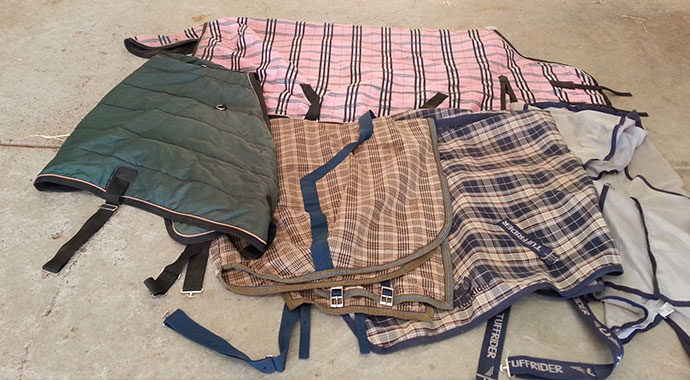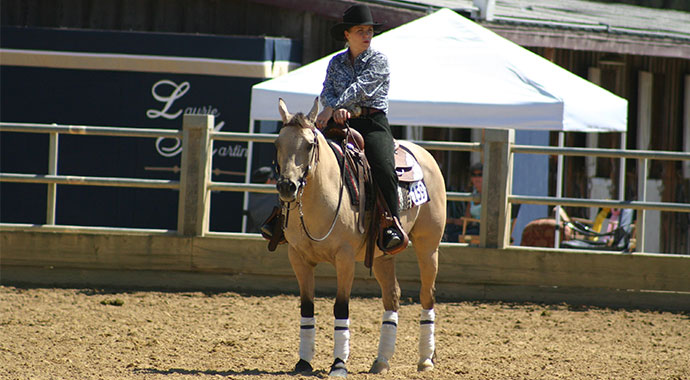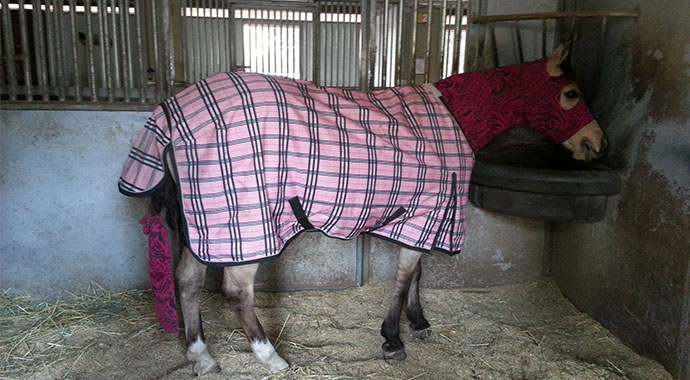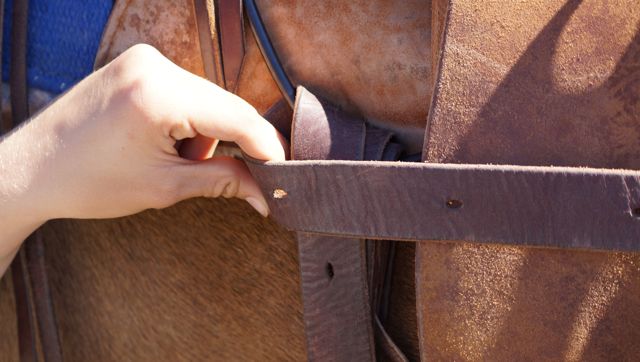Choosing a blanket for your horse is a lot like finding a good pair of shoes. There are hundreds to choose from, some are cute but uncomfortable, others are comfortable but cheaply made, and some simply refuse to fit correctly no matter how much you want them to.
When it comes to putting something “unnatural” on your horse, you have to do your best to make sure that it fits. Proper fit is more important than anything else, including brand and style. To find your horse’s correct size, use a flexible measuring tape to measure from the center of the breast, just below the neck, along his side, to the center of the rear / tail. This should give you a number, somewhere in the range of 68 to 82 depending upon the size of your horse. Most blankets are numbered evenly, so if you get, for instance 71, it is best to round up and consider your horse a 72 in size.
Now you need to choose the correct style. If your horse lives in a paddock, stall with a run, or pasture, you might want to consider a “turnout” blanket. These blankets are typically higher on the withers, have shoulder gussets, and often have a tail flap and longer length on the sides; all things to reduce rubbing and discomfort while the horse is moving. A horse confined to a box stall or barn stall can get away with wearing a “stable blanket”, which typically does not have shoulder gussets, is shorter in side length and more contoured to the body. Finally, there is the “sheet”. A sheet has no “fill”, and is typically for use in either rain protection or just keeping your horse clean, but they offer little in way of real warmth.
Some horse owners are lucky; They throw a properly sized blanket on their horse and it fits perfectly the first time. Many of us, however, find an entire host of issues associated with blankets that either cause them to slip, create unsightly rub marks on the shoulders, irritate the withers, etc. So, when looking for a blanket, take into account your horse’s conformation and choose one that is either adjustable at the shoulders, or specifically suggests that it is a good fit for your particular horse’s conformation type. For instance, my Half Arabian has a very wide chest, and although it might seem strange, she does best in a blanket that is cut for a Quarter Horse. You must also consider whether or not your horse is hard on his clothing, which may require you to get a blanket specifically designed with rip-stop material.
Next comes weight. Blankets typically come in “no fill”, “light fill”, “medium fill” and “heavy fill”. This has to do with how much insulation, and thus warmth, the blanket provides. If your horse has a naturally thick coat, and you do not plan to clip or keep him on lights, a light-fill blanket will probably suffice. An older horse, one with a thinner coat, or one that is kept short for show reasons, will need a medium or heavy fill blanket at night, and possibly a light weight sheet during the day.
If your horse has access to the outdoors, you will need to specifically buy a waterproof blanket. If your horse is in a box stall, you can get away with a non-waterproof blanket. Remember, one of the worst things that you can do is put a non-waterproof blanket on a horse that can get wet — think of wearing a wet jacket while standing outside all night — or to put a too heavy blanket, without moisture wicking properties, on a horse that will cause him to sweat.
The reality of the matter is that many horses will have multiple blankets for multiple purposes. The best we can do is to know our horse’s blanket needs, correct size, conformation issues, and then go online and read reviews (or speak with friends who have horses similar in size and shape) prior to purchasing. Additionally, it is helpful to purchase from a supplier that will accept returns, that way you can try the blanket on your “clean” horse and if it obviously does not fit, you can return it.
Part 3 of this article will deal with when to blanket based on San Luis Obispo County’s many unique and varied areas of temperature.




